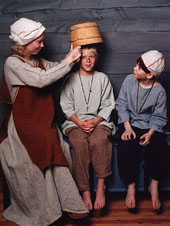Meet the Middle Ages
BackThe Peasants

During late Iron Age, only parts of the country were inhabited. There are Iron Age burial fields at Kråkerum and Kronobäck. In the early Middle Ages, there were a few small villages along the coast. The other peasants in the region lived on single farms. During the early Middle Ages, there was a considerable expansion of the district. The villages became bigger and new land was cleared in the wooded in-lands. Place-names with –ryd ( cleared land), -hult ( meadow) and –måla (claimed territory) indicate such settlements.
Many of the Stranda farmers had their own property and paid taxes to the crown. They were free-holders, "skattebönder". The gentry owned land and property on the coast and on the borders. The peasants who farmed this land were tenant farmers –" frälsebönder". They leased the farm from the nobleman and paid taxes to him. The lease would usually be renewed every six years. When the lease was up for renewal, an additional fee was often claimed. It might have been rather more troublesome to have been a tenant farmer than a free-holder. In many villages on the coast, there were both tenant farmers and free-holders.
The church, the bishop and the convents were land-owners, too. Their tenant farmers were called church- bishop- or convent-farmers. The convent at Vadstena, the nunnery in Kalmar and the monastery in Kronobäck all owned a lot of property in Stranda.
The peasants led the usual lives of farmers, growing crops and keeping livestock. In the woodlands, the farmers would make an additional living from forestry, charcoal-burning, tar-making and the production of iron.
The farm-land expansion continued until the second half of the 14th century. In the summer of 1350, the plague, the "Black Death", struck Kalmar and by autumn it had reached the coast and the wood-lands of Stranda. The effects of the plague were very severe, particularly so in areas with a small population. One effect of the plague was a decrease in farming during the latter part of the 14th and first part of the 15th century. Farming did not pick up until the end of the 15th century, because the plague struck time and time again; in 1363-66, in 1393-99, in 1404-06 and in 1411-16.